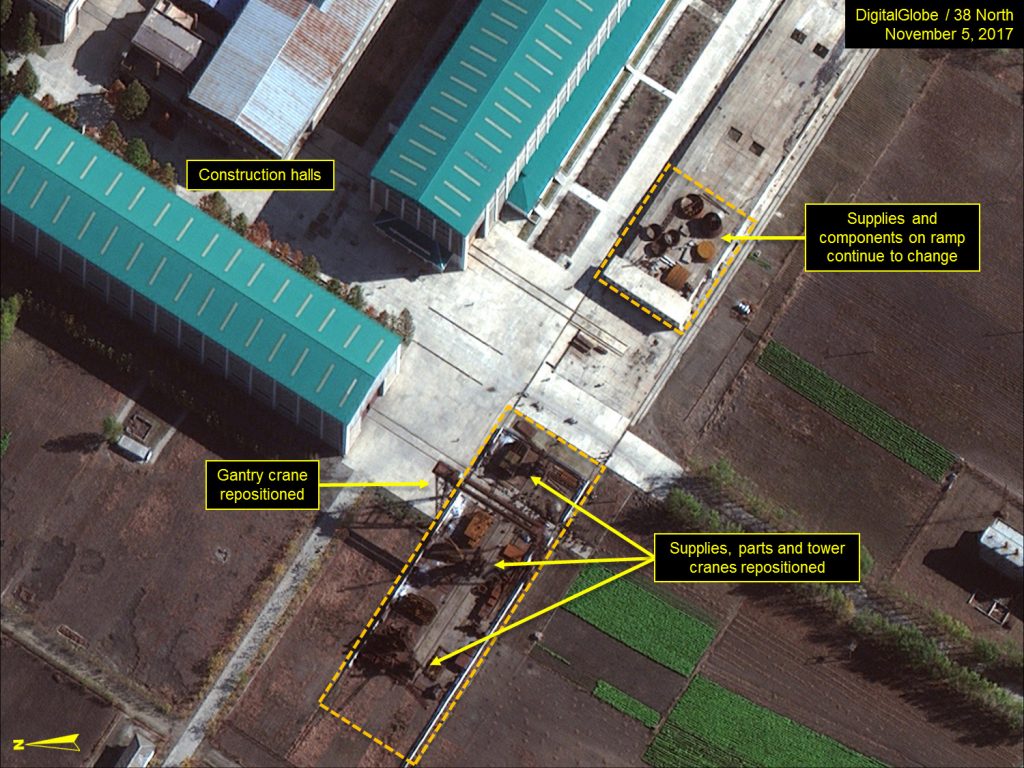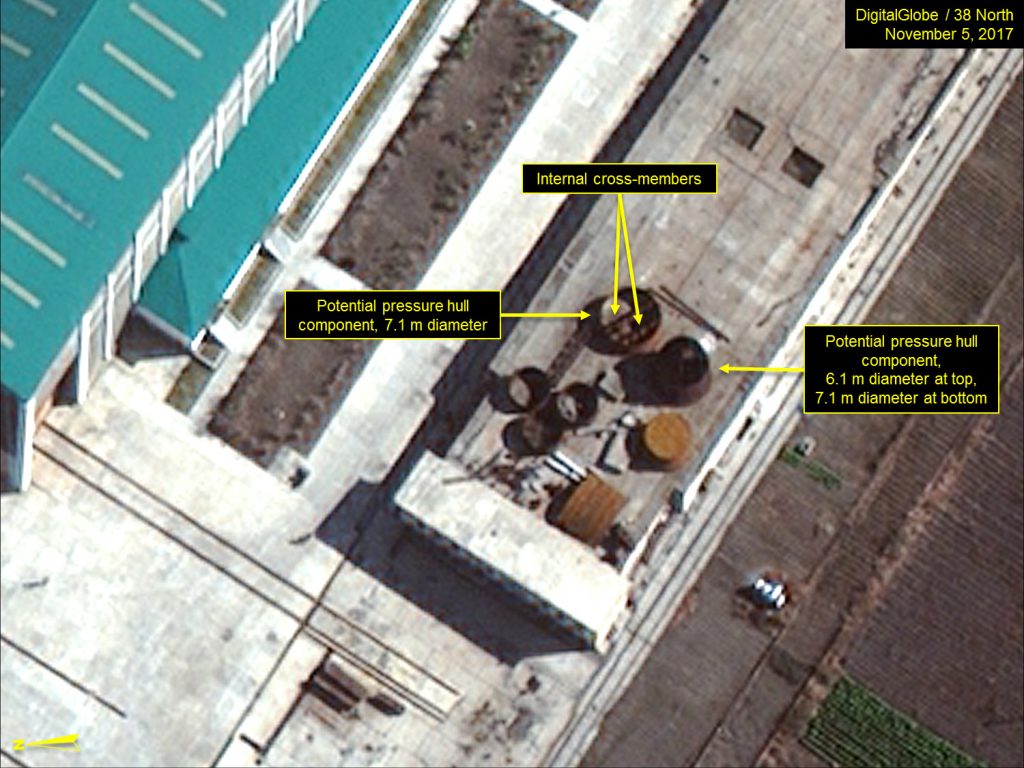North Korea’s Submarine Ballistic Missile Program Moves Ahead: Indications of Shipbuilding and Missile Ejection Testing
A 38 North exclusive with analysis by Joseph S. Bermudez Jr.
Commercial satellite imagery of the Sinpo South Shipyard from November 5 indicates that North Korea is on an aggressive schedule to build and deploy its first operational ballistic missile submarine.The continued movement of parts and components into and out of the parts yards adjacent to the construction halls indicates an ongoing shipbuilding program. The presence of what appear to be sections of a submarine’s pressure hull in the yards suggests construction of a new submarine, possibly the SINPO-C ballistic missile submarine (SSB)[1]—the follow-on to the current SINPO-class experimental ballistic missile submarine (SSBA).[2]
A probable launch canister support, or launch canister, appears to be present within the service tower at the missile test stand suggesting the ongoing ejection testing of submarine launch ballistic missiles (SLBM). Such testing could support the continued development of SLBMs, a new ballistic missile submarine or a combination of both.
Both the SINPO-class submarine and submersible missile test stand barge remain berthed at the same locations as observed since last August and appear capable of putting to sea at any time of Pyongyang’s choosing; however, there are no activities suggesting a forthcoming at-sea or submerged test of a Pukguksong-1/KN-11, a potential Pukguksong-3, or other SLBM.
Building of a New Submarine
Throughout 2017 there has been continued movement of parts and components into and out of the two parts yards adjacent to the constructions halls in the center of the shipyard. Accompanying this has been the movement of the gantry and tower cranes that service the yards.[3] These activities suggest a prolonged and ongoing shipbuilding program, which is supported by the fact that the Sinpo South Shipyard has historically been the primary manufacturer of large submarines for the Korean People’s Navy (KPN).
Imagery from November 5 shows two larger circular objects that may be sections of a submarine’s pressure hull. The diameter of the first object is approximately 7.1 meters, while the diameter of the second starts at approximately 7.1 meters and reduces to approximately 6.1 meters. The larger object has what appears to be two internal cross members that could be used to support decks or internal equipment. If these assessments are correct, then the shipbuilding program is for a submarine with a beam broader (in width) than the ROMEO-class attack submarine (6.7 meters)—meaning it is potentially a SINPO-C SSB, the reported follow-on to the SINPO-class SSBA.
Figure 1. Continued movement of parts and components observed at parts yards adjacent to construction halls.

Figure 2. Close-up of one parts yard shows potential pressure hull components.

At the test stand, imagery from November 5 shows an object visible at the top of the service tower that appears to be either a launch canister support or launch canister. This object does not appear in previous satellite or ground images of the test stand. While there is no additional activity of note in the immediate area, the service tower remains in place. During the earlier development of the Pukguksong-1/KN-11, it was removed after testing campaigns. Therefore, the continued presence of this object suggests ongoing SLBM ejection tests. If correct, this is likely a continuation of the ejection test campaign reported during July of this year.[4] Regardless, additional ejection tests should be expected in the future for further development of the Pukguksong-1, a potential Pukguksong-3, or other future SLBMs. Such a test would also be valuable for validating missile launch systems for a new class of SSBs.
Figure 3. Close-up of the missile test stand indicates launch canister support or launch canister present at service tower.


Imagery from November 5 shows both the SINPO-class submarine and submersible missile test stand barge remain berthed at the same locations in the secure boat basin as observed over the past four months. The tarps (or netting) suspended over the decks of the SINPO-class submarine observed in August remain in place. (A lower resolution image from September 21 suggested that the tarps had been removed but this appears incorrect.) The KPN has employed tarps or netting suspended over ships and submarines on a number of occasions to conceal activity from both ground and overhead (i.e., satellites, etc.) observation or in deception operations. Their exact purpose in this case is unclear.
A pennant number (unreadable) is visible on the side of the conning tower and a small unidentified yellow-colored object on the deck immediately to the aft can be seen—pennant numbers are typically assigned to a submarine after it has been accepted into service by the KPN. No equipment or personnel are observed on the dock adjacent to the submarine or test stand barge, and no support vessels are present in the secure boat basin. Support vessels have been used during previous tests conducted from the submersible test stand barge to tow the barge into position and provide electricity and compressed air to the barge. While both the submarine and test stand barge appear able to put to sea at relatively short notice, no activities are observed suggesting a forthcoming at-sea or submerged SLBM test.
Located 3.8 kilometers to the east of the Sinpo South Shipyard is a large dry-dock that is likely associated with the shipyard. During November-December 2016, a ROMEO-class attack submarine from the Mayang-do Shipyard was transferred to this dry-dock. Here it has been undergoing what appears to be a complete overhaul. At present, the outer hull has been removed from most of the submarine exposing its inner pressure hull. Such a lengthy time in dry-dock is not unusual. Another ROMEO-class attack submarine from the West Sea Fleet has been in dry-dock at the Tasa-ri Shipyard on the northwest coast since at least September 2013.
Figure 4. SINPO-class submarine and submersible test stand barge berthed in the secure boat basin.

Figure 5. ROMEO-class submarine overhauled at dry-dock.

Construction of the new construction/maintenance hall on the southern tip of the Yuktaeso-ri (Sinpo) Peninsula, which began in 2012, continues very slowly. Located on the west side of the Yuktaeso-ri Peninsula, the modernization and rebuilding of the port of Nopyong-ni is also continuing very slowly. While the construction of the construction/maintenance hall at Yuktaeso-ri may be related to the future development and deployment of a SSB capability, this does not appear to be the case at Nopyong-ni.
Figure 6. Construction of new construction hall continues at slow pace.
Figure 7. Construction of L-shaped pier continues.

Figure 8. Modernization of port of Nopyong-ni ongoing.

- [1] A designation by the US intelligence community first reported in October 2017. Ankit Panda, “The Sinpo-C-Class: A New North Korean Ballistic Missile Submarine Under Construction,” The Diplomat, October 18, 2017, https://thediplomat.com/2017/10/the-sinpo-c-class-a-new-north-korean-ballistic-missile-submarine-is-under-construction/.
- [2] South Korean intelligence refers to this as the GORAE-class submarine.
- [3] It is interesting to note that during September 2017, one of the two gantry cranes servicing the parts yards was removed.
- [4] See: “US detects ‘highly unusual’ North Korean submarine activity,” CNN, July 31, 2017, http://www.cnn.com/2017/07/31/politics/north-korea-ejection-test-submarine-activity/index.html, and “N. Korea conducts SLBM ejection test,” Yonhap, August 1, 2017, http://english.yonhapnews.co.kr/national/2017/08/01/23/0301000000AEN20170801007100315F.html.



Ingen kommentarer:
Legg inn en kommentar
Merk: Bare medlemmer av denne bloggen kan legge inn en kommentar.